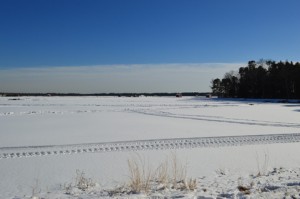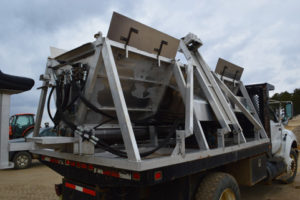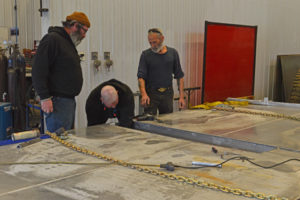Sanding, our biggest winter project, continues this week, but we’ve made some changes since the last batch of ice started melting!
We are currently running two sanding teams, and one of them has begun using the new, larger sander, designed to increase our speed and efficiency! We’ve redesigned our sanding plan a couple of times over the years, as we’re always looking at what are the best practices for the crop, and this new machine will help us reach our targets.
“We started thinking about this a couple of years ago when we wanted to increase our sanding practices and cover about a quarter of the farm every year,” says COO Bryan vonHahmann. “The wintertime can be tough, not knowing what Mother Nature’s going to do to us. So shortening the time to sand while increasing number of acres was a challenge! Our initial thought was to increase the size of the equipment by fifty percent, taking it from 10 feet to 15 feet, but we were leery of the amount of water that would displace and how much we’d be able to flood the bogs, not to mention the mechanical problems it poses. We settled on going twenty percent bigger; it’s patterned after our existing sanders, but 12 feet wide with a bigger hopper. It’s already a huge improvement; with the old sanders, the excavator could fill them in three swings with two buckets of sand and a partial third. This new one takes three good-size bucket loads, and since that’s still only three swings on the excavator, it takes roughly the same amount of time to load but it’s covering 20% more ground. This gives us a 10% net increase in coverage, with our goal being putting another one in operation before we start sanding next year and get a full 20% increase.”
The team is still thinking of ways to increase speed and efficiency, however. Because the sanders can only come up to the dam to for a fresh load of sand, there’s a distance from the ditches at both the beginning and end of the dam which can be missed. “We’ve also purchased a used side-discharge manure spreader to fill in the gaps,” Bryan says. “We’ve retrofitted it to slow it down, then did a fair amount of experimenting and finally came up with something that seems to be working. What we do is we drive it down the dam and it throws sand out the side, roughly 15 to 20 feet. We’ve only just started using it, and the wind affects it quite a bit; it needs a calm day with no ice on the beds.”
While the machine was not running much this week, thanks to the weather, operator Wilfredo Pagan has been very pleased and is very excited about the increased speed and coverage area. And if the weather cooperates, we’re hoping to get some video so you can see it in action!



